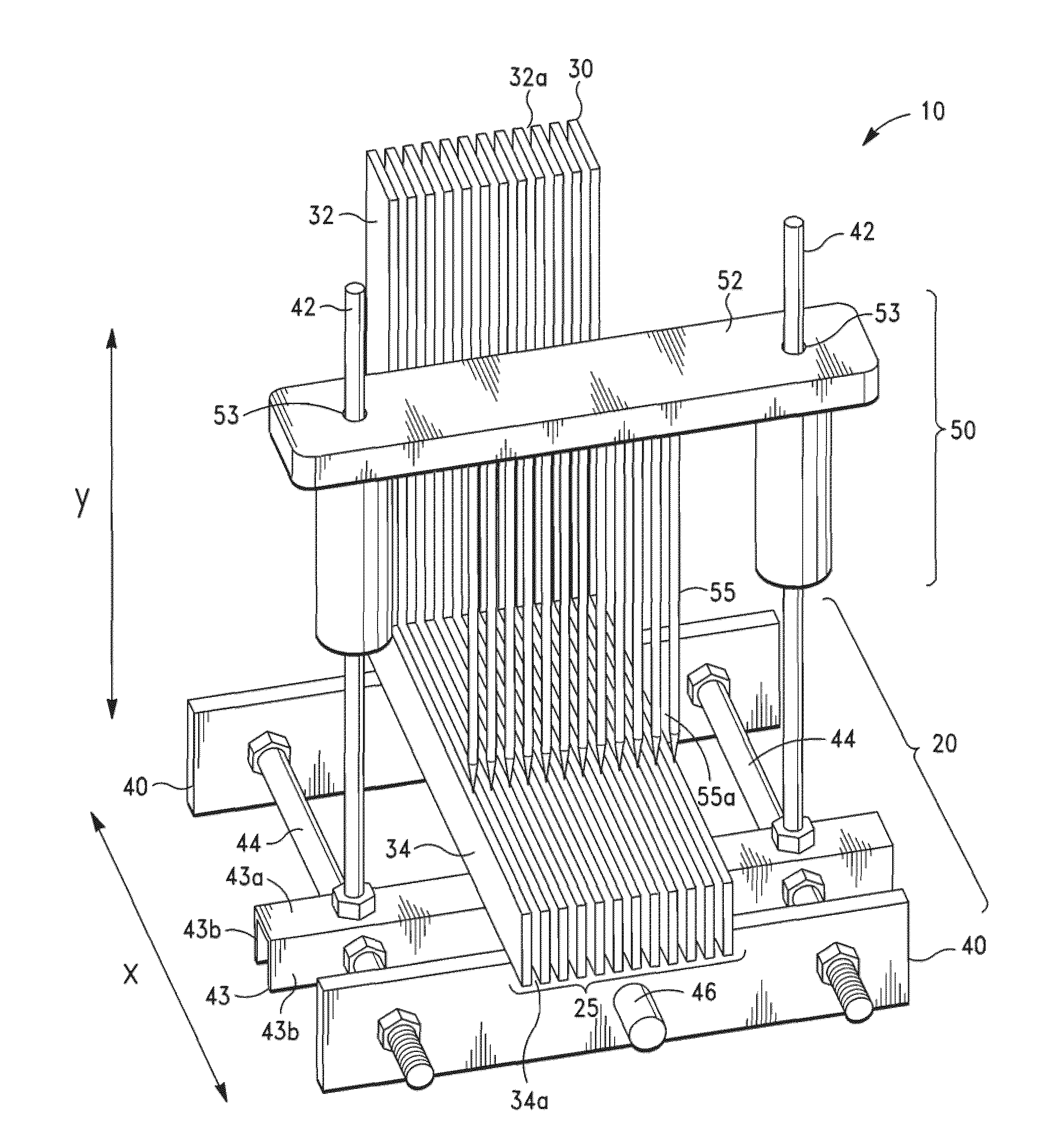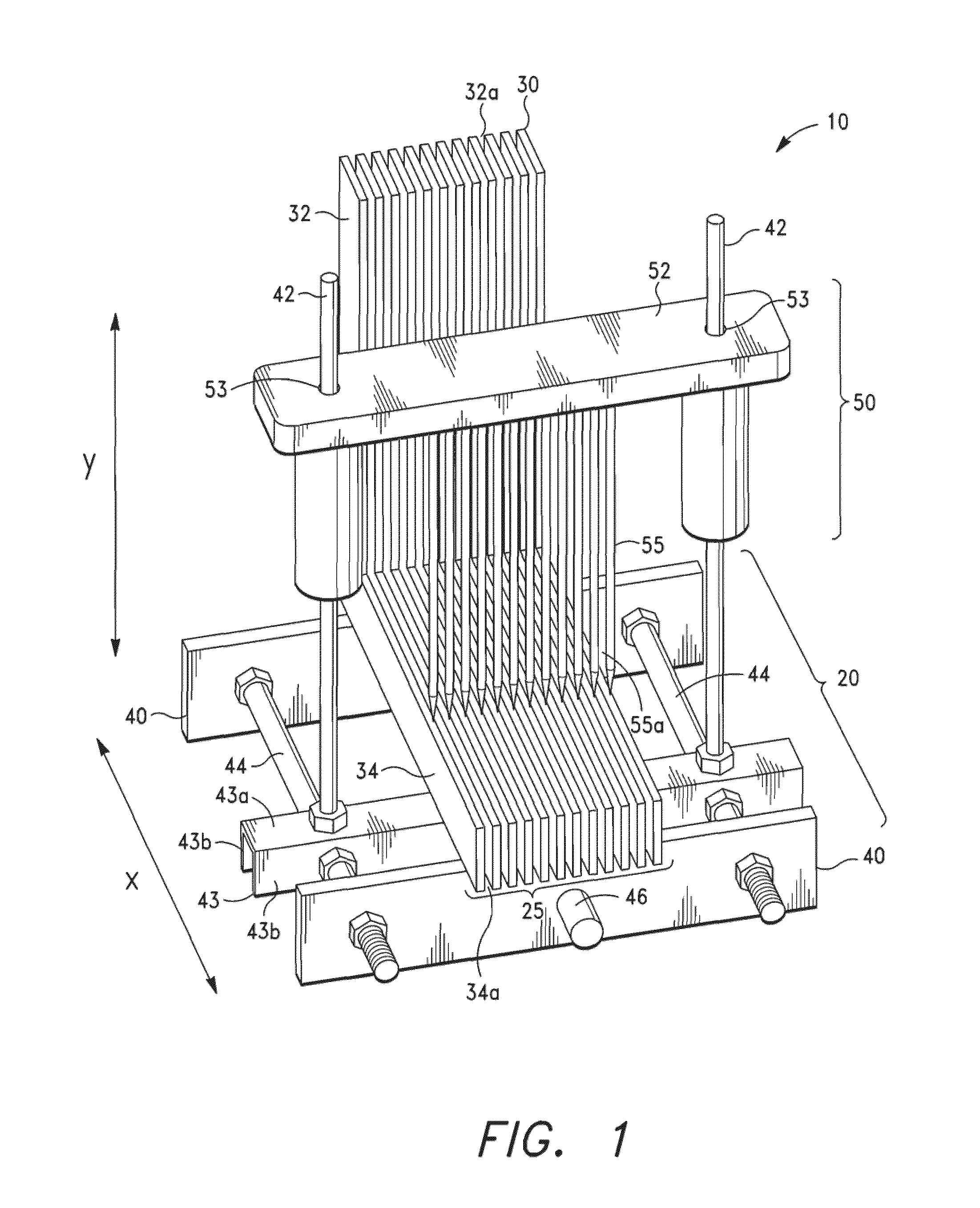Tissue Slicer
a tissue slicer and tissue technology, applied in the field of biological tissue slicers, can solve the problems of affecting pathologists' gross evaluation of surgical tissue specimens, so as to improve the quality of tissue sections, minimize trauma and structural distortion, and optimize processing
- Summary
- Abstract
- Description
- Claims
- Application Information
AI Technical Summary
Benefits of technology
Problems solved by technology
Method used
Image
Examples
first embodiment
[0040]FIGS. 1 to 7B illustrate a tissue slicer 10 in accordance with the present invention. As shown in FIG. 1, the tissue slicer 10 comprises a base 20 having a partially open horizontal surface 25. The partially open surface 25 has a plurality of openings or slits that permit one or more cutting blade(s) to traverse therethrough. The base 20 is comprised of a plurality of plates 30, preferably angled plates 30, which are aligned to create the openings. The angled plates are aligned in parallel such that there is a gap between the adjacent plates 30. The angled plates 30 preferably comprise metal L-shaped plates, each having a vertical member 32 and a horizontal member 34 spaced about 1 to 10 mm apart (e.g., 1, 2, 3, 4, 5, 6, 7, 8, 9, 10 mm apart, or as needed). The gaps 32a between the vertical members 32 are adapted to receive the blade(s) in the tissue slicer and also function as a guide for precise cutting. The biological tissue specimen may also be positioned against the verti...
second embodiment
[0050]FIGS. 8 to 11 illustrate a biological tissue slicer 210 in accordance with the present invention. The tissue slicer 210 comprises a base plate 220 and at least one vertical member 230 for engaging a dual pivoting member 240 connected to a blade cartridge 260 (as discussed more fully below). The base plate 220 is adapted to receive a removable pin base 252 holding a plurality of pins 255 that forms a partially open horizontal surface 225. The pins are preferably pointed where they engage the tissue specimen, but need not be as shown in the figures. FIG. 8 illustrates the plurality of pins 255 in a linear rectangular configuration; however, the pins may be configured in other geometric and non-geometric configurations. In addition, the pins may be spaced either equidistantly (e.g., about 2 to 6 mm, preferably about 4 mm) or non-equidistantly relative to one another. However, the pins are positioned such that there are gaps 255a that permit the cutting blades 265 in the blade car...
third embodiment
[0055]FIGS. 12 to 16B illustrate a tissue slicer 310 in accordance with the present invention. As shown in FIGS. 12 to 14A, the tissue slicer 310 comprises a base 320 having a partially open horizontal surface 325. The base 320 is comprised of a plurality of horizontal plate members 334 spaced about 1 to 10 mm apart (e.g., 1, 2, 3, 4, 5, 6, 7, 8, 9, 10 mm apart, or as needed). The horizontal plate members 334 function as a partially open horizontal surface 325 where the tissue specimen is positioned. The gaps 334a between the horizontal plate members 34 are adapted to receive the blades(s) in the tissue slicer so that the blade(s) can extend through and cut the entire tissue specimen (and even beyond the thickness of the tissue specimen).
[0056]The base 320 having the horizontal plates 334 is mounted to a frame 340 to maintain the horizontal plate members 334 in an adjustable position. The base 320 includes a means for slidably moving the base 320 relative to the pins 355 along the f...
PUM
 Login to View More
Login to View More Abstract
Description
Claims
Application Information
 Login to View More
Login to View More - R&D
- Intellectual Property
- Life Sciences
- Materials
- Tech Scout
- Unparalleled Data Quality
- Higher Quality Content
- 60% Fewer Hallucinations
Browse by: Latest US Patents, China's latest patents, Technical Efficacy Thesaurus, Application Domain, Technology Topic, Popular Technical Reports.
© 2025 PatSnap. All rights reserved.Legal|Privacy policy|Modern Slavery Act Transparency Statement|Sitemap|About US| Contact US: help@patsnap.com



